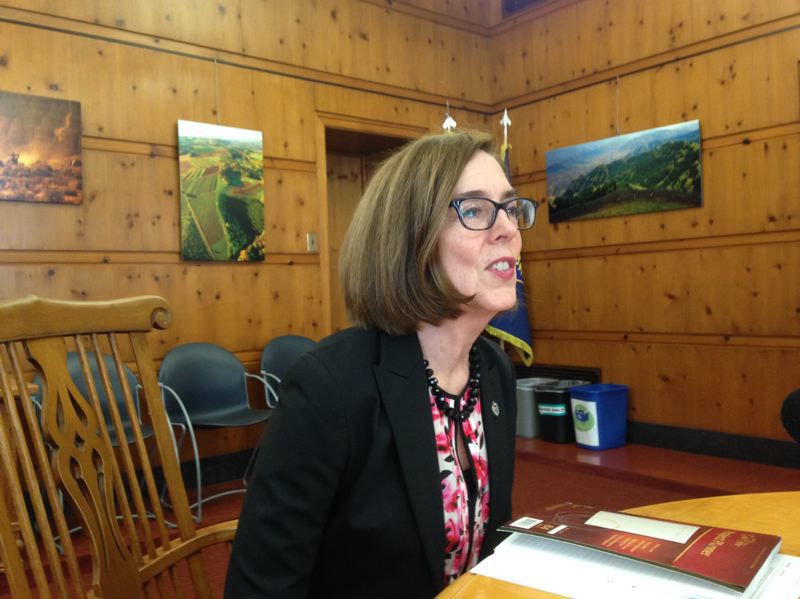Brown sets June 21 target to end COVID-19 limits in Oregon
Published 10:36 am Friday, June 4, 2021

- EO MEDIA GROUP file photo
Nearly all COVID-19 restrictions could be lifted in as early as just over two weeks, Gov. Kate Brown said Friday.
The state is about 127,000 adults short of the goal of getting at least one shot of vaccine into 70% of eligible adult residents.
Trending
Once the state crosses the threshold, Brown said she would lift masking, business capacity, event size, social distance and other limits that Oregonians have dealt with for most of the past 15 months.
“We can fully reopen — we can all look forward to that,” she said.
Brown and top state health leaders made the announcements during a Friday morning press call.
After the vaccination goal is met, Brown said local health officials would take over the daily decision-making and operations in counties from the Oregon Health Authority.
Brown listed what the changes would mean to the state’s 4.24 million resident:
“Fourth of July barbecues, eating popcorn in a movie theater, getting a beer after work at the local brewery with your friends,” she said. “Restaurants and bars able to welcome a full house. The Pendleton Round-Up? Yes, that, too.”
Oregon’s statewide mark stood at 66.2% on Wednesday.
The first full day of summer – Monday, June 21 – was the optimistic target that state was trying to reach, Allen said.
“This is not a slam dunk,” Allen said.
Allen said a June 30 estimated earlier this spring was well within reach.
“It will take a lot of work by a lot of people to get it done,” Allen said.
Lifting restrictions would include:
• Ending the risk level system for counties of lower, moderate, high and extreme.
• Ending a state requirement for masks and face coverings in almost all settings. Exceptions would be airports, public transit, and health care settings that follow federal agency guidelines.
• End requirements for individuals to show vaccination verification in public venues and businesses.
• Allow K-12 students to attend school in-person, full time, five days per week.
K-12 guidance is being revised to support schools in safely delivering in-person instruction throughout the school day.
Current health and safety standards, including indoor mask requirements, will remain in place in workplaces, schools and child care settings.
Colleges and universities can make their own decisions on protocols after considering guidance from the Centers for Disease Control.
Brown said lifting restrictions did not mean the public health crisis in Oregon was close to over. Because there are few current options for those under age 16, only a little more than half of the state population is vaccinated today.
Brown will re-examine whether or not to lift her emergency order that gave her a wide latitude on public health decisions.
“The pandemic will not be over,” Brown said.
To try to increase the vaccination rate toward the goal, many pharmacies will extend hours to reach out to more people who want shots.
“Some people are not vaccine resistant, but vaccine inconvenienced,” Allen said.
Brown also reiterated plans to give away $1 million to a vaccinated Oregonian, along with $10,000 to a vaccinated person in each of the 36 counties. Scholarships worth $100,000 are also being offered to lucky vaccinated youth.
Brown and OHA officials said it was time to push past the current levels of inoculation as medical evidence and state statistics show the impact of the virus has separated residents into two groups with very different likely futures.
“This has really become a tale of two pandemics,” Brown said. “If you are vaccinated then you’re safe, you can carry on safely without wearing a mask and social distancing. If you are not vaccinated, this virus still poses a very real threat.”
Children, immunocompromised, cancer patients and those who have not been able to get vaccinated for any reason must still be considered when communities decide what steps to take.
“There are still Oregonians who need to take extra precautions to feel and stay safe,” Brown said.
If someone is unvaccinated, they remain a danger to family, friends and others in their communities who could get sick or die.
“So, it will remain incredibly important for Oregonians to continue making smart choices,” Brown said.
OHA will continue to monitor the global pandemic and provide assistance and resources, but will increasingly advise local officials on measures to take.
OHA and CDC are expected to issue more guidance in coming days as the state nears the 70% goal.
Friday, June 4 was the 500th day since COVID-19 was first reported in the United States in Snohomish County, Wash., on Jan. 21, 2020.
Oregon reported its first COVID-19 case on Feb. 28, 2020 in Washington County. The state has since reported totals of 202,675 infections and 2,682 deaths, according to the Oregon Health Authority.
Just over 33.34 million infections have been reported since then, with 596,910 deaths, the Johns Hopkins Coronavirus Resource Center reported Friday.
Worldwide, over 172.3 million infections of COVID-19 have been reported, with over 3.7 million reported deaths, according to Johns Hopkins.





